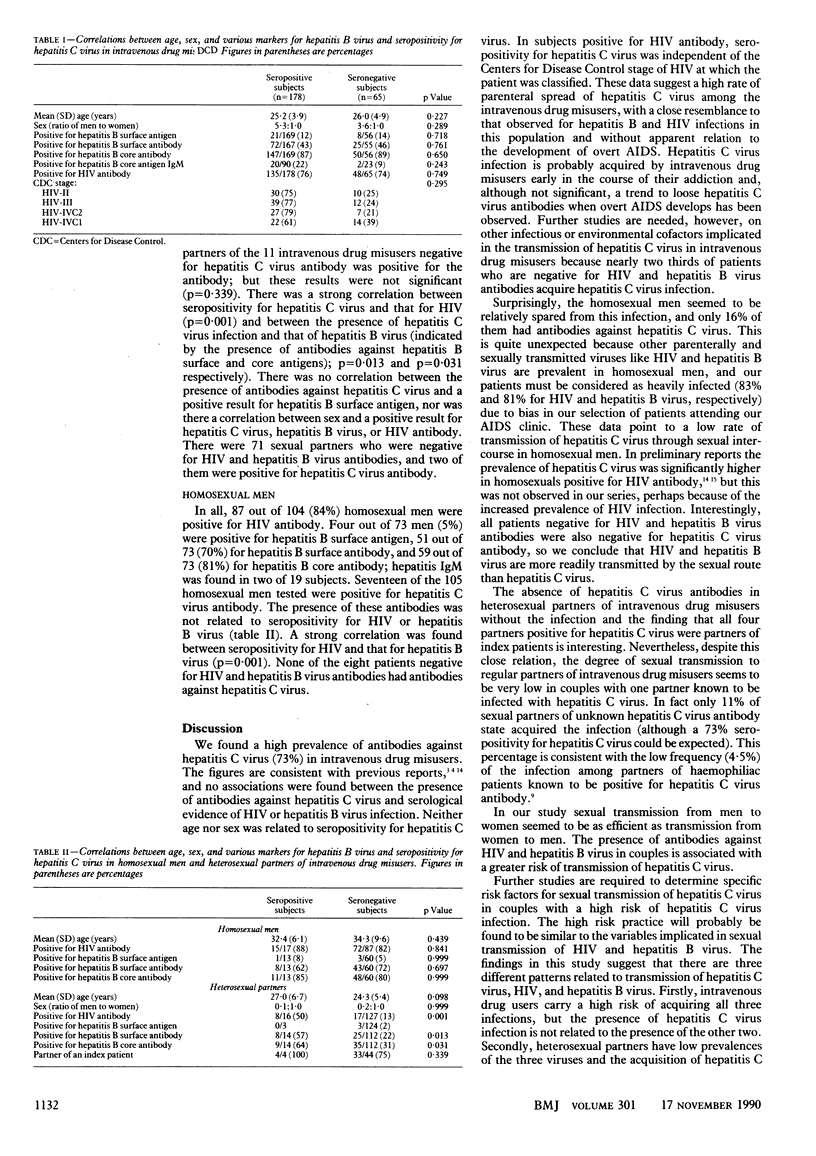Abstract
OBJECTIVE--To determine the extent of transmission of hepatitis C virus in sexual partners of intravenous drug misusers and to examine the relation between the prevalences of HIV, hepatitis B virus, and hepatitis C virus infections in homosexual men and intravenous drug misusers and their sexual partners. DESIGN--Serum samples collected between 1984 and 1988 were tested for hepatitis B virus markers and antibodies against hepatitis C virus by enzyme linked immunosorbent assay (ELISA) and for HIV antibody by enzyme immune analysis and western blotting. SETTING--Large referral university hospital with an external AIDS clinic in the metropolitan area of Barcelona, Spain. SUBJECTS--243 Intravenous drug misusers, 143 of their regular heterosexual partners, and 105 homosexual men. MAIN OUTCOME MEASURES--Prevalences of hepatitis C virus, hepatitis B virus, and HIV infections. RESULTS--In all, 178 of the 243 (73%) intravenous drug misusers, 16 out of 143 (11%) of their partners, and 17 of the 105 (16%) homosexual men had antibodies against hepatitis C virus. The presence of hepatitis C virus infection was unrelated to sex, age, the presence of HIV or hepatitis B virus infections, or the Centers for Disease Control stage of HIV. In sexual partners of intravenous drug misusers there were strong correlations between the presence of hepatitis C virus infection and that of HIV (p = 0.001) and hepatitis B virus (p = 0.013) infections. CONCLUSIONS--Intravenous drug misusers have a high risk of acquiring hepatitis C virus, hepatitis B virus, and HIV infections, but the presence of hepatitis C virus infection seems to be unrelated to the presence of the other two viruses. Homosexual men have a high prevalence of HIV and hepatitis B virus infections with a low prevalence of hepatitis C virus infection, the presence of which is not related to that of the other two infections. Conversely, heterosexual partners of intravenous drug misusers have low prevalences of the three virus infections, but the presence of hepatitis C virus infection correlates significantly with the presence of HIV and hepatitis B infections. The rate of sexual transmission of hepatitis C virus seems to be low, even in partners of people known to be seropositive for this virus.
Full text
PDF



Selected References
These references are in PubMed. This may not be the complete list of references from this article.
- Alter H. J., Purcell R. H., Shih J. W., Melpolder J. C., Houghton M., Choo Q. L., Kuo G. Detection of antibody to hepatitis C virus in prospectively followed transfusion recipients with acute and chronic non-A, non-B hepatitis. N Engl J Med. 1989 Nov 30;321(22):1494–1500. doi: 10.1056/NEJM198911303212202. [DOI] [PubMed] [Google Scholar]
- Alter M. J., Coleman P. J., Alexander W. J., Kramer E., Miller J. K., Mandel E., Hadler S. C., Margolis H. S. Importance of heterosexual activity in the transmission of hepatitis B and non-A, non-B hepatitis. JAMA. 1989 Sep 1;262(9):1201–1205. [PubMed] [Google Scholar]
- Bruix J., Barrera J. M., Calvet X., Ercilla G., Costa J., Sanchez-Tapias J. M., Ventura M., Vall M., Bruguera M., Bru C. Prevalence of antibodies to hepatitis C virus in Spanish patients with hepatocellular carcinoma and hepatic cirrhosis. Lancet. 1989 Oct 28;2(8670):1004–1006. doi: 10.1016/s0140-6736(89)91015-5. [DOI] [PubMed] [Google Scholar]
- Choo Q. L., Kuo G., Weiner A. J., Overby L. R., Bradley D. W., Houghton M. Isolation of a cDNA clone derived from a blood-borne non-A, non-B viral hepatitis genome. Science. 1989 Apr 21;244(4902):359–362. doi: 10.1126/science.2523562. [DOI] [PubMed] [Google Scholar]
- Colombo M., Kuo G., Choo Q. L., Donato M. F., Del Ninno E., Tommasini M. A., Dioguardi N., Houghton M. Prevalence of antibodies to hepatitis C virus in Italian patients with hepatocellular carcinoma. Lancet. 1989 Oct 28;2(8670):1006–1008. doi: 10.1016/s0140-6736(89)91016-7. [DOI] [PubMed] [Google Scholar]
- Esteban J. I., Esteban R., Viladomiu L., López-Talavera J. C., González A., Hernández J. M., Roget M., Vargas V., Genescà J., Buti M. Hepatitis C virus antibodies among risk groups in Spain. Lancet. 1989 Aug 5;2(8658):294–297. doi: 10.1016/s0140-6736(89)90485-6. [DOI] [PubMed] [Google Scholar]
- Kuo G., Choo Q. L., Alter H. J., Gitnick G. L., Redeker A. G., Purcell R. H., Miyamura T., Dienstag J. L., Alter M. J., Stevens C. E. An assay for circulating antibodies to a major etiologic virus of human non-A, non-B hepatitis. Science. 1989 Apr 21;244(4902):362–364. doi: 10.1126/science.2496467. [DOI] [PubMed] [Google Scholar]
- Mortimer P. P., Cohen B. J., Litton P. A., Vandervelde E. M., Bassendine M. F., Brind A. M., Hambling M. H. Hepatitis C virus antibody. Lancet. 1989 Sep 30;2(8666):798–798. doi: 10.1016/s0140-6736(89)90854-4. [DOI] [PubMed] [Google Scholar]
- Roggendorf M., Deinhardt F., Rasshofer R., Eberle J., Hopf U., Möller B., Zachoval R., Pape G., Schramm W., Rommel F. Antibodies to hepatitis C virus. Lancet. 1989 Aug 5;2(8658):324–325. doi: 10.1016/s0140-6736(89)90501-1. [DOI] [PubMed] [Google Scholar]
- Zuckerman A. J. The elusive hepatitis C virus. BMJ. 1989 Oct 7;299(6704):871–873. doi: 10.1136/bmj.299.6704.871. [DOI] [PMC free article] [PubMed] [Google Scholar]


